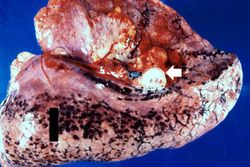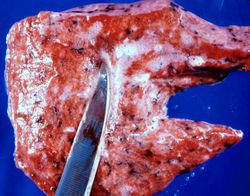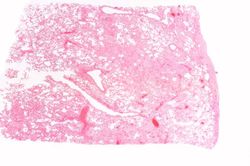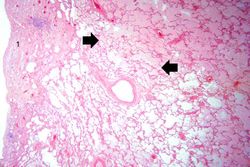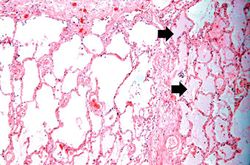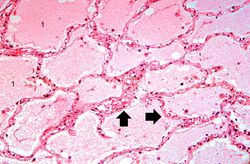IPLab:Lab 4:Pulmonary Congestion and Edema
Contents
Clinical Summary[edit]
This 69-year-old male with well-controlled Type II diabetes mellitus presented with upper abdominal and lower chest pain of four hours duration and accompanied by shortness of breath and diaphoresis. An electrocardiogram revealed multiple premature ventricular contractions (PVCs). The hospital course was characterized by recurrent pulmonary edema and oliguria. The terminal event was cardiac arrest.
Significant findings at postmortem examination were old and recent myocardial infarctions and evidence of congestive heart failure. The right and left lungs weighed 950 grams and 750 grams, respectively, and were reddish-brown.
Images[edit]
Virtual Microscopy[edit]
Lung: Congestion and Edema[edit]
Normal Lung[edit]
Study Questions[edit]
- Define the following:
Additional Resources[edit]
Reference[edit]
Journal Articles[edit]
- Welch TD, Yang EH, Reeder GS, Gersh BJ. Modern management of acute myocardial infarction. Curr Probl Cardiol 2012 Jul;37(7):237-310.
Images[edit]
Related IPLab Cases[edit]
- Lab 1: Heart: Myocardial Infarction (Coagulative Necrosis)
- Lab 3: Heart: Acute Myocardial Infarction
- Lab 3: Heart: Healed Myocardial Infarction
- Lab 4: Heart: Mural Thrombus
- Lab 4: Coronary Artery: Thrombosis
| |||||
Shortness of breath is a common clinical manifestation of heart failure.
Diaphoresis is a profuse perspiration often seen during a myocardial infarction.
Premature ventricular contractions (PVCs) are a common cardiac arrhythmia. They are present even in healthy individuals, for whom no treatment is indicated. However, in patients with heart disease, PVCs can be significant indicators of disease processes. For example, increased numbers of PVCs are common following an acute myocardial infarction.
Pulmonary edema refers to the accumulation of fluid in the pulmonary alveolar and tissue spaces as a result of changes in capillary permeability and/or increases in capillary hydrostatic pressure.
Oliguria is the occurrence of decreased urine output.
Cardiac arrest is the sudden standstill of cardiac function.
A normal right lung weighs 450 grams (range: 360 to 570 grams.
A normal left lung weighs 375 grams (range: 325 to 480 grams).
Pulmonary congestion is the engorgement of pulmonary vessels with blood. The increased pressure caused by this engorgement leads to transudation of fluid through the capillary walls and into the alveolar and interstitial spaces.

